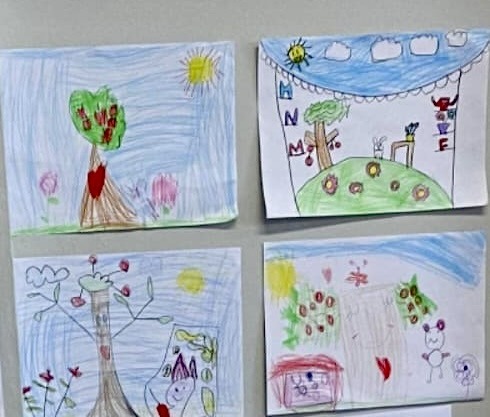

CPI’s Storytelling Program in Istanbul is dedicated to preserving Turkey’s rich cultural heritage through the art of stories.
Storytelling provides several advantages to children. As children listen to stories, they acquire knowledge, establish connections with their cultural heritage, and help carry forward traditions


CPI employs various methods to help pre-reading children interpret stories.
Besides the classic approach of drawing, we also uses magic clay and other arts and crafts activities to engage the children with the stories they’ve listened to.
A boy explains his drawing to Zeynep during a session.

Drawing from the rich tapestry of Anatolian folklore, CPI’s storytelling program in Turkey introduces children to timeless tales that inspire moral teachings and cultural pride. Through interactive sessions in kindergartens and schools, children are immersed in the magical world of storytelling, offering them a glimpse into their cultural heritage while fostering creativity and imagination.
The program goes beyond storytelling by incorporating elements of creative drama, engaging children in physical warm-ups and improvisational exercises. These activities encourage children to explore their creativity, develop their storytelling skills, and build confidence in expressing themselves. By combining storytelling with creative expression, CPI’s program in Turkey provides children with a safe space to grow emotionally, connect with their roots, and envision brighter futures.

Anatolian stories refer to the rich and diverse folklore and traditional tales originating from Anatolia, a region in Turkey.
These stories are deeply rooted in Turkish culture and have been passed down orally from generation to generation.
They often feature a mix of mythology, history, and moral lessons, offering insights into the values, beliefs, and customs of Anatolian society.
Anatolian stories encompass a wide range of themes, including heroism, love, adventure, and the supernatural, and they continue to play a significant role in Turkish literature, art, and entertainment.
The Guardian writes: “The oral folktales of the Anatolian plateau are a remarkable blend of storytelling motifs and traditions, drawing on the Arabian Nights and Brothers Grimm, as well as Kurdish, Persian, Slavonic, Jewish and Romanian influences.”
In CPI's workshops, children don’t just listen passively—they become active participants in the storytelling process. Whether it’s retelling a story with a twist, creating their own narratives, or bringing scenes to life through acting, every activity is designed to ignite their imagination and foster critical thinking. In the first session, she asked the children to retell a part of the story in their own words.



CPI’s storytelling programs prioritize the creation of a safe space, which is essential for fostering trust, emotional expression, and connection. These spaces provide children with an environment free from judgment or fear, where they feel valued and supported. In a safe space, children can open up, share their feelings, and engage with stories in ways that promote healing, creativity, and personal growth. By setting boundaries through opening and closing rituals and ensuring inclusivity, CPI’s safe spaces empower children to process their emotions, build resilience, and connect with their peers and cultural heritage.
CPI’s Storytelling Manual guides our partners, who tailor it to fit their cultural requirements and practical needs.
In Turkey, CPI has applied her own techinqes to the warm-up ritual, involving more physical activities followed by arts and crafts.

By integrating art into storytelling, CPI fosters emotional healing, strengthens cultural connections, and empowers children to develop their creativity in meaningful ways.
CPI recommends incorporating drawing as a creative activity following storytelling sessions. Through art, children can communicate complex ideas and emotions that they may struggle to express verbally due to a lack of vocabulary.
Drawing provides a safe and imaginative outlet for children to process stories, explore their feelings, and share their unique perspectives.
The goal is for each child to paint or draw their understanding and representation of a chosen story. This hands-on activity not only enhances comprehension but also nurtures creativity and self-expression.
Additionally, CPI’s Fairy Tale Storybook project invites children to create their own storybook covers and fill them with drawings inspired by the stories they hear during the program.

534 W. 112 Street,
P.O.Box 250765
New York, NY 10025
CPI is a nonprofit tax-exempt organization under section 501(c)(3) of the U.S, Internal Revenue Code.
Registered Charity: EIN 85-0677829
Link to CPI’s Annual Report 2024 here
© 2025 Childsplay International (CPI). All rights reserved. Anyone may distribute, remix, adapt, and build upon any material in this website, in any format, provided that such use is consistent with CPI’s objectives, and provided that it includes the following statement: “This material originates with Childsplay International and its website.”